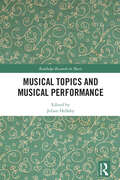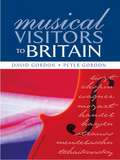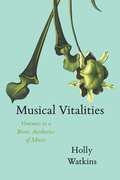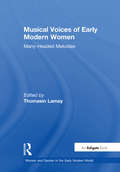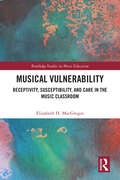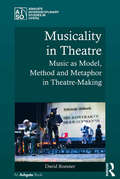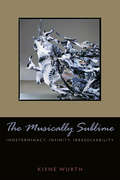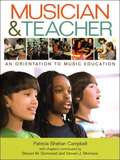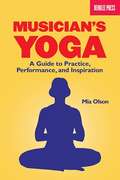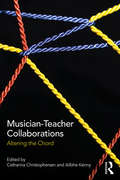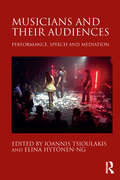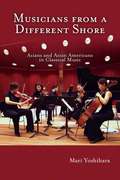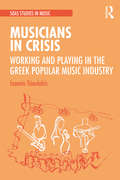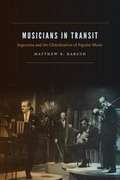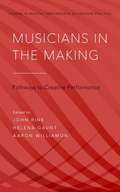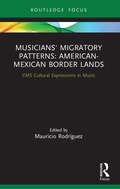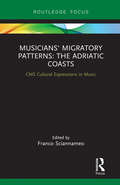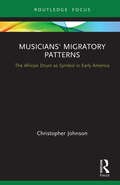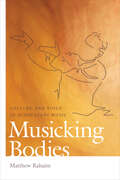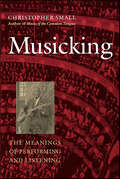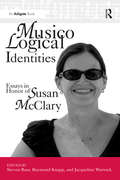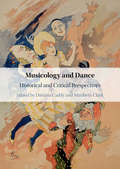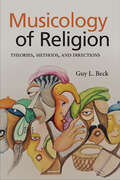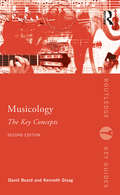- Table View
- List View
Musical Topics and Musical Performance (Routledge Research in Music)
by Julian HellabyThe principal purpose of topics in musicology has been to identify meaning-bearing units within a musical composition that would have been understood by contemporary audiences and therefore also by later receivers, albeit in a different context and with a need for historically aware listening. Since Leonard Ratner (1980) introduced the idea of topics, his relatively simple ideas have been expanded and developed by a number of distinguished authors. Topic theory has now become a well-established branch of musicology, often embracing semiotics, but its relationship to performance has received less attention. Musical Topics and Musical Performance thus focuses on the interface of theory and practice, and investigates how an appreciation of topical presence in a work may prompt interpretative thoughts for a potential performer as well as how performers have responded to such a presence in practice. The chapters focus on music from the nineteenth, twentieth and twenty-first centuries with case studies drawn from composers as diverse as Beethoven, Scriabin and Péter Eötvös. Using both scores and recordings, the book presents a variety of original and innovative perspectives on the subject from a range of distinguished authors, and addresses a neglected area of musicology and musical performance.
Musical Visitors to Britain (Woburn Education Series)
by Peter GordonBritain has attracted many musical visitors to its shores. A varied and often eccentric collection of individuals, some were invited by royalty with musical tastes, some were refugees from religious or political oppression, some were spies, and others came to escape debt or even charges of murder. This book paints a broad picture of the changing nature of musical life in Britain over the centuries, through the eyes and ears of foreign musicians. After considering three of the eighteenth century’s greatest musical figures, the authors consider the rise of the celebrity composer in the nineteenth century, and go on to consider the influence of new forms of transport which allowed travel more freely from the Continent and the USA. Musical Visitors to Britain also charts the new opportunities presented by the opening of public halls, the growth of music festivals, and the regular influx of composers in the twentieth and twenty-first centuries, ending with the impact of new musical forms such as jazz. As much a social as a musical history of Britain, this book will be of interest to anyone studying or working in these fields, as well as to general readers who want to discover more about our musical heritage.
Musical Vitalities: Ventures in a Biotic Aesthetics of Music (New Material Histories of Music)
by Holly WatkinsDoes it make sense to refer to bird song—a complex vocalization, full of repetitive and transformative patterns that are carefully calculated to woo a mate—as art? What about a pack of wolves howling in unison or the cacophony made by an entire rain forest? Redefining music as “the art of possibly animate things,” Musical Vitalities charts a new path for music studies that blends musicological methods with perspectives drawn from the life sciences. In opposition to humanist approaches that insist on a separation between culture and nature—approaches that appear increasingly untenable in an era defined by human-generated climate change—Musical Vitalities treats music as one example of the cultural practices and biotic arts of the animal kingdom rather than as a phenomenon categorically distinct from nonhuman forms of sonic expression. The book challenges the human exceptionalism that has allowed musicologists to overlook music’s structural resemblances to the songs of nonhuman species, the intricacies of music’s physiological impact on listeners, and the many analogues between music’s formal processes and those of the dynamic natural world. Through close readings of Austro-German music and aesthetic writings that suggest wide-ranging analogies between music and nature, Musical Vitalities seeks to both rekindle the critical potential of nineteenth-century music and rejoin the humans at the center of the humanities with the nonhumans whose evolutionary endowments and planetary fates they share.
Musical Voices of Early Modern Women: Many-Headed Melodies (Women and Gender in the Early Modern World)
by Thomasin LamayRecent scholarship has offered a veritable landslide of studies about early modern women, illuminating them as writers, thinkers, midwives, mothers, in convents, at home, and as rulers. Musical Voices of Early Modern Women adds to the mix of early modern studies a volume that correlates women's musical endeavors to their lives, addressing early modern women's musical activities across a broad spectrum of cultural events and settings. The volume takes as its premise the notion that while women may have been squeezed to participate in music through narrower doors than their male peers, they nevertheless did so with enthusiasm, diligence, and success. They were there in many ways, but as women's lives were fundamentally different and more private than men's were, their strategies, tools, and appearances were sometimes also different and thus often unstudied in an historical discipline that primarily evaluated men's productivity. Given that, many of these stories will not necessarily embrace a standard musical repertoire, even as they seek to expand canonical borders. The contributors to this collection explore the possibility of a larger musical culture which included women as well as men, by examining early modern women in "many-headed ways" through the lens of musical production. They look at how women composed, assuming that compositional gender strategies may have been used differently when applied through her vision; how women were composed, or represented and interpreted through music in a larger cultural context, and how her presence in that dialog situated her in social space. Contributors also trace how women found music as a means for communicating, for establishing intellectual power, for generating musical tastes, and for enhancing the quality of their lives. Some women performed publicly, and thus some articles examine how this impacted on their lives and families. Other contributors inquire about the economics of music and women, and how in different situations some women may have been financially empowered or even in control of their own money-making. This collection offers a glimpse at women from home, stage, work, and convent, from many classes and from culturally diverse countries - including France, Spain, Italy, England, Austria, Russia, and Mexico - and imagines a musical history centered in the realities of those lives.
Musical Vulnerability: Receptivity, Susceptibility, and Care in the Music Classroom (Routledge Studies in Music Education)
by Elizabeth H. MacGregorSince the early twenty- first century, music education across the world has been shaped by neoliberal discourse extolling the benefits of music upon academic achievement, health and wellbeing, and social development. However, such benefits are far from universal; on the contrary, music- making often reveals our shortcomings and dependencies. This highlights an urgent need for music education to be reframed by an understanding of ‘musical vulnerability’: our inherent and situational openness to being affected by the semantic and somatic properties of music- making.Drawing on existing vulnerability studies, this book evaluates how musicmaking can foster both positive receptivity and negative susceptibility, depending on its delineation of self- identity, social identity, and space, and its embodiment through aural receptivity, mimetic participation, and affective transmission. Through phenomenological, ethnographic research with teachers and pupils, it exposes how values espoused in the music classroom require the personal and interpersonal negotiation of conflicting musical expectations, identities, and abilities. It makes recommendations for music education policymakers, teachers, and researchers in diverse global contexts, suggesting the importance of developing ‘pedagogies of vulnerability’ in order to foster caring classroom music- making praxes that acknowledge music’s capacity both to heal and to harm.
Musicality in Theatre: Music as Model, Method and Metaphor in Theatre-Making (Ashgate Interdisciplinary Studies in Opera)
by David RoesnerAs the complicated relationship between music and theatre has evolved and changed in the modern and postmodern periods, music has continued to be immensely influential in key developments of theatrical practices. In this study of musicality in the theatre, David Roesner offers a revised view of the nature of the relationship. The new perspective results from two shifts in focus: on the one hand, Roesner concentrates in particular on theatre-making - that is the creation processes of theatre - and on the other, he traces a notion of ‘musicality’ in the historical and contemporary discourses as driver of theatrical innovation and aesthetic dispositif, focusing on musical qualities, metaphors and principles derived from a wide range of genres. Roesner looks in particular at the ways in which those who attempted to experiment with, advance or even revolutionize theatre often sought to use and integrate a sense of musicality in training and directing processes and in performances. His study reveals both the continuous changes in the understanding of music as model, method and metaphor for the theatre and how different notions of music had a vital impact on theatrical innovation in the past 150 years. Musicality thus becomes a complementary concept to theatricality, helping to highlight what is germane to an art form as well as to explain its traction in other art forms and areas of life. The theoretical scope of the book is developed from a wide range of case studies, some of which are re-readings of the classics of theatre history (Appia, Meyerhold, Artaud, Beckett), while others introduce or rediscover less-discussed practitioners such as Joe Chaikin, Thomas Bernhard, Elfriede Jelinek, Michael Thalheimer and Karin Beier.
Musically Sublime: Indeterminacy, Infinity, Irresolvability
by Kiene Brillenburg WurthMusically Sublime rewrites musically the history and philosophy of the sublime. Music enables us to reconsider the traditional course of sublime feeling on a track from pain to pleasure. Resisting the notion that there is a single format for sublime feeling, Wurth shows how, from the mid eighteenth century onward, sublime feeling is, instead, constantly rearticulated in a complex interaction with musicality. Wurth takes as her point of departure Immanuel Kant's Critique of Judgment and Jean-François Lyotard's aesthetic writings of the 1980s and 1990s. Kant framed the sublime narratively as an epic of self-transcendence. By contrast, Lyotard sought to substitute open immanence for Kantian transcendence, yet he failed to deconstruct the Kantian epic. The book performs this deconstruction by juxtaposing eighteenth- and nineteenth-century conceptions of the infinite, Sehnsucht, the divided self, and unconscious drives with contemporary readings of instrumental music. Critically assessing Edmund Burke, James Usher, E.T.A. Hoffmann, Novalis, Friedrich Hölderlin, Arthur Schopenhauer, Richard Wagner, and Friedrich Nietzsche, this book re-presents the sublime as a feeling that defers resolution and hangs suspended between pain and pleasure. Musically Sublime rewrites the mathematical sublime as différance, while it redresses the dynamical sublime as trauma: unending, undetermined, unresolved.Whereas most musicological studies in this area have focused on traces of the Kantian sublime in Handel, Haydn, and Beethoven, this book calls on the nineteenth-century theorist Arthur Seidl to analyze the sublime of, rather than in, music. It does so by invoking Seidl's concept of formwidrigkeit ("form-contrariness") in juxtaposition with Romantic piano music, (post)modernist musical minimalisms, and Lyotard's postmodern sublime. It presents a sublime of matter, rather than form-performative rather than representational. In doing so, Musically Sublime shows that the binary distinction Lyotard posits between the postmodern and romantic sublime is finally untenable.
Musician and Teacher: An Orientation to Music Education
by Patricia Shehan Campbell Steven M. Demorest Steven J. MorrisonDesigned for the first course in music education, Musician & Teacher surveys the theoretical, philosophical, historical, social, and psychological foundations of teaching music and pays tribute to the local and global realms of music teaching and learning. At the same time, the book examines the developmental issues inherent in teaching music to children and adolescents along with the practicalities of motivating students and managing a classroom, providing the concrete application beginning educators need to successfully teach music to children in grades K-12.
Musician from the Darkness
by Claude ClementAn outsider in a primitive hunting society learns about the power of music as both an agent of destruction and consolation.
Musician's Yoga: A Guide to Practice, Performance, and Inspiration
by Mia OlsonPractice meditation approaches, breathing techniques, and yoga postures that will help improve musicianship Play using healthy posture and technique Get more out of your practice through improved focus Use your breath to improve your phrasing and also to ease performance anxiety Play with deeper expression through inspiration.
Musician-Teacher Collaborations: Altering the Chord
by Ailbhe Kenny Catharina ChristophersenMusician-Teacher Collaborations: Altering the Chord explores the dynamics between musicians and teachers within educational settings, illustrating how new musical worlds are discovered and accessed through music-in-education initiatives. An international array of scholars from ten countries present leading debates and issues—both theoretical and empirical—in order to identify and expand upon key questions: How are visiting musicians perceived by various stakeholders? What opportunities and challenges do musicians bring to educational spaces? Why are such initiatives often seen as "saving" children, music, and education? The text is organized into three parts: Critical Insights presents new theoretical frameworks and concepts, providing alternative perspectives on musician-teacher collaboration. Crossing Boundaries addresses the challenges faced by visiting musicians and teaching artists in educational contexts while discussing the contributions of such music-in-education initiatives. Working Towards Partnership tackles some dominant narratives and perspectives in the field through a series of empirically-based chapters discussing musician-teacher collaboration as a field of tension. In twenty chapters, Musician-Teacher Collaborations offers critical insights into the pedagogical role music plays within educational frameworks. The geographical diversity of its contributors ensures varied and context-specific arguments while also speaking to the larger issues at play. When musicians and teachers collaborate, one is in the space of the other and vice versa. Musician-Teacher Collaborations analyzes the complex ways in which these spaces are inevitably altered.
Musicians and their Audiences: Performance, Speech and Mediation
by Ioannis Tsioulakis Elina Hytönen-NgHow do musicians play and talk to audiences? Why do audiences listen and what happens when they talk back? How do new (and old) technologies affect this interplay? This book presents a long overdue examination of the turbulent relationship between musicians and audiences. Focusing on a range of areas as diverse as Ireland, Greece, India, Malta, the US, and China, the contributors bring musicological, sociological, psychological, and anthropological approaches to the interaction between performers, fans, and the industry that mediates them. The four parts of the book each address a different stage of the relationship between musicians and audiences, showing its processual nature: from conceptualisation to performance, and through mediation to off-stage discourses. The musician/audience conceptual division is shown, throughout the book, to be as problematic as it is persistent.
Musicians from a Different Shore: Asians and Asian Americans in Classical Music
by Mari YoshiharaIn the first book to account for the growing prominence of Asians in the world of Western classical music, Mari Yoshihara grapples with the significance of this trend. This is a book about the about the origins of a social and cultural phenomenon, but it is also about the lives and work of individual musicians devoted to their art.
Musicians in Crisis: Working and Playing in the Greek Popular Music Industry (SOAS Studies in Music)
by Ioannis TsioulakisMusicians in Crisis is a music ethnography of contemporary Athens, before and during the infamous economic and political crisis. It spans two contrasting periods in Greece: the last few years of relative economic prosperity and social cohesion (2005–2009) and the following period of austerity and socio-political turmoil (2010–2017). Based on the author’s participation and professional involvement in the local music scenes since 2005, the monograph untangles a web of creative practices, economic strategies and social ideologies through the previously unheard voices of Athenian music professionals. The book follows the life stories of freelance musicians of different genders, ages, educational backgrounds and musical genres, while they ‘work’ and ‘play’ in Athenian venues, recording studios and classrooms. Adding to the growing literature on precarity and resistance in the creative industries, it traces the effects of unprecedented socioeconomic circumstances on musicians’ everyday experience, as well as the actions and solidarities that help them to navigate personal and collective devastation. Through rich and evocative testimonies from the labourers of an industrious popular music scene, Musicians in Crisis contests popular narratives of the Greek predicament as they are reported by political and financial elites through international media. In this process, the book tells a story about how popular music is made in the liminal spaces between East and West, affuence and poverty, harmony and turmoil.
Musicians in Transit: Argentina and the Globalization of Popular Music
by Matthew B. KarushIn Musicians in Transit Matthew B. Karush examines the transnational careers of seven of the most influential Argentine musicians of the twentieth century: Afro-Argentine swing guitarist Oscar Alemán, jazz saxophonist Gato Barbieri, composer Lalo Schifrin, tango innovator Astor Piazzolla, balada singer Sandro, folksinger Mercedes Sosa, and rock musician Gustavo Santaolalla. As active participants in the globalized music business, these artists interacted with musicians and audiences in the United States, Europe, and Latin America and contended with genre distinctions, marketing conventions, and ethnic stereotypes. By responding creatively to these constraints, they made innovative music that provided Argentines with new ways of understanding their nation’s place in the world. Eventually, these musicians produced expressions of Latin identity that reverberated beyond Argentina, including a novel form of pop ballad; an anti-imperialist, revolutionary folk genre; and a style of rock built on a pastiche of Latin American and global genres. A website with links to recordings by each musician accompanies the book.
Musicians in the Making: Pathways to Creative Performance (Studies In Musical Performance As Creative Practice Series)
by John Rink Helena Gaunt Aaron WilliamonThis book explores the creative development of musicians in both formal and informal learning contexts. It promotes a novel view of creativity, emphasizing its location within creative processes rather than understanding it as an innate quality. It argues that such processes may be learned and refined, and furthermore that collaboration and interaction within group contexts carry significant potential to inform and catalyze creative experiences and outcomes. The book also traces and models the ways in which creative processes evolve over time. Performers, music teachers and researchers will find the rich body of material assembled here engaging and enlightening. The book's three parts focus in turn on 'Creative learning in context', 'Creative processes' and 'Creative dialogue and reflection'. In addition to sixteen extended chapters written by leading experts in the field, the volume includes ten 'Insights' by internationally prominent performers, performance teachers and others. Practical aids include abstracts and lists of keywords at the start of each chapter, which provide useful overviews and guidance on content. Topics addressed by individual authors include intrapersonal and interpersonal dynamics, performance experience, practice and rehearsal, 'self-regulated performing', improvisation, self-reflection, expression, interactions between performers and audiences, assessment, and the role of academic study in performers' development.
Musicians' Migratory Patterns: American-Mexican Border Lands (CMS Cultural Expressions in Music)
by Mauricio RodríguezMusicians’ Migratory Patterns: American-Mexican Border Lands considers the works and ideologies of an array of American-based, immigrant Mexican musicians. It asserts their immigrant status as a central force in nourishing, informing, and propelling musical and artistic concerns, uncovering pure and fresh forms of expression that broaden the multicultural map of Mexico. The text guides readers in appreciation of the aesthetic and technical achievements of original works and innovative performances, with artistic and pedagogical implications that frame a vivid picture of the contemporary Mexican as immigrant creator in the United States. The ongoing displacement of Mexicans into the United States impacts not only American economic conditions but the country’s social, cultural, and intellectual configurations as well. Artistic and academic voices shape and enrich the multicultural diversity of both countries, as immigrant Mexican artists and their musics prove instrumental to the forming of a self-critical society compelled to value and embrace its diversity. Despite conflicting political reactions on this complex subject of legal and illegal immigration, undeniable is the influence of Mexican musical expressions in the United States and Mexico, at the border and beyond.
Musicians' Migratory Patterns: The Adriatic Coasts (CMS Cultural Expressions in Music)
by Franco SciannameoMusicians’ Migratory Patterns: The Adriatic Coasts contains essays dedicated to the movement of musicians along and across the coasts of the Adriatic Sea. In the course of this book, the musicians become narrators of their own stories seen through the lenses of wanderlust, opportunity, exile, and refuge. Essayists in this collection are scholars hailing from Croatia, Italy, and Greece. They are internationally known for their passionate advocacy of musicians’ migratory rights and faithfulness to the lesson imparted by the history of immigration in the broadest of terms. Spanning the Venetian Republic’s domination, the demise of the Ottoman Empire, the European nationalistic movements of mid-nineteenth century, the shocking outcomes of World War One, and the dramatic shifts of frontiers that continue to occur in our time, the chapters of this book guide the reader on a voyage through the Adriatic Sea—from the Gulf of Venice and the peninsula of Istria, to Albania, the Island of Corfu, and other Ionian outposts.
Musicians' Migratory Patterns: The African Drum As Symbol In Early America (CMS Cultural Expressions in Music)
by Christopher JohnsonMusicians’ Migratory Patterns: The African Drum as Symbol in Early America questions the ban that was placed on the African drum in early America. It shows the functional use of the drum for celebrations, weddings, funerals, religious ceremonies, and nonviolent communication. The assumption that "drums and horns" were used to communicate in slave revolts is undone in this study. Rather, this volume seeks to consider the "social place" of the drum for both blacks and whites of the time, using the writings of Europeans and colonial-era Americans, the accounts of African American free persons and slaves, the period instruments, and numerous illustrations of paintings and sculpture. The image of the drum was effectively appropriated by Europeans and Americans who wrote about African American culture, particularly in the nineteenth century, and re-appropriated by African American poets and painters in the early twentieth century who recreated a positive nationalist view of their African past. Throughout human history, cultural objects have been banned by one group to be used another, objects that include books, religious artifacts, and ways of dress. This study unlocks a metaphor that is at the root of racial bias—the idea of what is primitive—while offering a fresh approach by promoting the construct of multiple-points-of-view for this social-historical presentation.
Musicking Bodies: Gesture and Voice in Hindustani Music (Music Culture)
by Matthew RahaimIndian vocalists trace intricate shapes with their hands while improvising melody. Although every vocalist has an idiosyncratic gestural style, students inherit ways of shaping melodic space from their teachers, and the motion of the hand and voice are always intimately connected. Though observers of Indian classical music have long commented on these gestures, Musicking Bodies is the first extended study of what singers actually do with their hands and voices. Matthew Rahaim draws on years of vocal training, ethnography, and close analysis to demonstrate the ways in which hand gesture is used alongside vocalization to manifest melody as dynamic, three-dimensional shapes. The gestures that are improvised alongside vocal improvisation embody a special kind of melodic knowledge passed down tacitly through lineages of teachers and students who not only sound similar, but who also engage with music kinesthetically according to similar aesthetic and ethical ideals. Musicking Bodies builds on the insights of phenomenology, Indian and Western music theory, and cultural studies to illuminate not only the performance of gesture, but its implications for the transmission of culture, the conception of melody, and the very nature of the musicking body.
Musicking: The Meanings of Performing and Listening (Music Culture)
by Christopher SmallExtending the inquiry of his early groundbreaking books, Christopher Small strikes at the heart of traditional studies of Western music by asserting that music is not a thing, but rather an activity. In this new book, Small outlines a theory of what he terms "musicking," a verb that encompasses all musical activity from composing to performing to listening to a Walkman to singing in the shower. Using Gregory Bateson's philosophy of mind and a Geertzian thick description of a typical concert in a typical symphony hall, Small demonstrates how musicking forms a ritual through which all the participants explore and celebrate the relationships that constitute their social identity. This engaging and deftly written trip through the concert hall will have readers rethinking every aspect of their musical worlds.
Musicological Identities: Essays in Honor of Susan McClary
by Jacqueline WarwickNo music scholar has made as profound an impact on contemporary thought as Susan McClary, a central figure in what has been termed the 'new musicology'. In this volume seventeen distinguished scholars pay tribute to her work, with essays addressing three approaches to music that have characterized her own writings: reassessing music's role in identity formation, particularly regarding gender, sexuality, and race; exploring music's capacity to define and regulate perceptions and experiences of time; and advancing new modes of analysis more appropriate to those aspects and modes of musicking ignored by traditional methods. Contributors include, in overlapping categories, many fellow pioneers, current colleagues, and former students, and their essays, like McClary's own work, address a wide range of repertories ranging from the established canon to a variety of popular genres. The collection represents the generational arrival of the 'new' musicology into full maturity, dividing fairly evenly between pre-eminent scholars of music and a group of younger scholars who have already made their mark in significant ways. But the collection is also, and fundamentally, interdisciplinary in nature, in active conversation with such fields as history, anthropology, philosophy, aesthetics, media studies, film music studies, dramatic criticism, women's studies, and cultural studies.
Musicology and Dance: Historical and Critical Perspectives
by Davinia Caddy Maribeth ClarkLong treated as peripheral to music history, dance has become prominent within musicological research, as a prime and popular subject for an increasing number of books, articles, conference papers and special symposiums. Despite this growing interest, there is a need for thorough-going critical examination of the ways in which musicologists might engage with dance, thinking not only about specific repertoires or genres, but about fundamental commonalities between the two, including embodiment, agency, subjectivity and consciousness. This volume begins to fill this gap. Ten chapters illustrate a range of conceptual, historical and interpretive approaches that advance the interdisciplinary study of music and dance. This methodological eclecticism is a defining feature, integrating insights from critical theory, cultural studies, the visual arts, phenomenology, cultural anthropology and literary criticism into the study of music and dance.
Musicology of Religion: Theories, Methods, and Directions (SUNY series in Religious Studies)
by Guy L. BeckFor generations, religion and music have been regarded as "universals," yet despite the fact that they have been frequently linked throughout history and topography, and despite the importance of music in the early stages of religious studies, their combined presence has not until now been considered a separate area of study and research. While there are well-developed fields of anthropology of religion, psychology of religion, and philosophy of religion, the widely recognized connections between religion and sound, chant, and music warrant comparable study. Drawing upon theories and methods in the study of both religion and music, referencing examples from world religious traditions, and addressing challenges posed by critics, this book envisions a unified field for religion and music: musicology of religion. Grounded in the scope and methods of phenomenology and comparative analysis, musicology of religion represents an innovative direction in interdisciplinary study, enriched by the social sciences, ethnomusicology, philosophy, theology, liturgical studies, and cognitive studies. As conceived, musicology of religion will spearhead new and creative paths in the study of religion.
Musicology: The Key Concepts (Routledge Key Guides)
by David Beard Kenneth GloagNow in an updated 2nd edition, Musicology: The Key Concepts is a handy A-Z reference guide to the terms and concepts associated with contemporary musicology. Drawing on critical theory with a focus on new musicology, this updated edition contains over 35 new entries including: Autobiography Music and Conflict Deconstruction Postcolonialism Disability Music after 9/11 Masculinity Gay Musicology Aesthetics Ethnicity Interpretation Subjectivity With all entries updated, and suggestions for further reading throughout, this text is an essential resource for all students of music, musicology, and wider performance related humanities disciplines.
